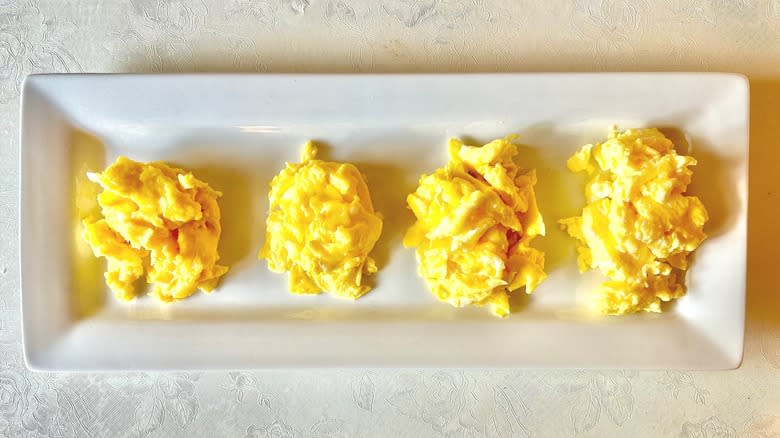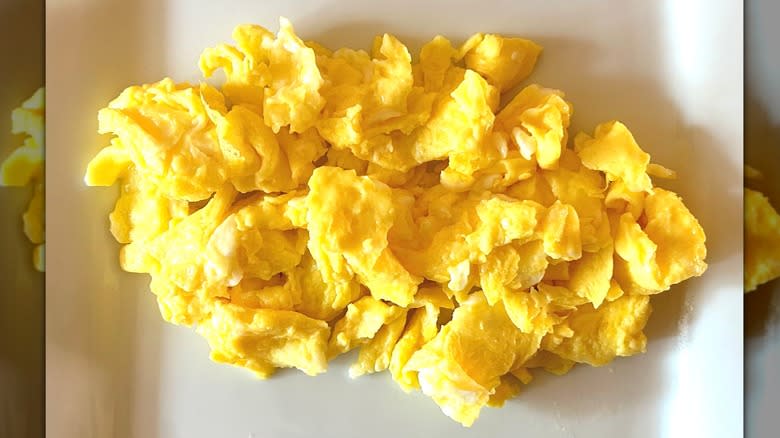We Solved The Milk Vs. Water Scrambled Egg Debate

Few breakfast options are as quick and beloved as scrambled eggs. They are a delicious, high-protein breakfast that can keep you fueled for hours. And while good scrambled eggs start with quality eggs, preferences for how best to enjoy them are as varied as human fingerprints. Some like them creamy and slightly loose, while others prefer them fluffy and more thoroughly cooked.
The key to all this relies upon how the eggs are prepared for cooking. Common considerations include the temperature at which the eggs are cooked, whether or not salt has been added, how much fat is added and the incorporation of starch into the mix. But perhaps the most hotly debated factor in how to cook the perfect scrambled eggs is if you should add milk or water to them.
We set out to settle this debate by taking to the kitchen to do a comprehensive analysis. This involved cooking several batches of scrambled eggs in a half tablespoon of unsalted butter, two at a time. We tried them without anything added, with water, with milk, and with a secret ingredient for comparison. We evaluated them on how they cooked, their texture, and, most importantly, their flavor. Our results may surprise you as much as they did us.
Read more: Secret Ingredients Celeb Chefs Use In Their Scrambled Eggs
What Is The Science Behind Adding Liquid To Scrambled Eggs?

You could invest in the snazziest spatula and highest quality non-stick pan, but none of this matters if you do not understand the science behind why eggs scramble in the first place. Eggs are made up of water, fat, and protein, predominantly in the form of ovalbumin. This type of protein behaves in a distinct way when it is exposed to heat.
As the proteins slowly warm up, they whip about, bumping into one another. The amino acid sequences begin tightly coiled together. As they warm up, they will slowly unfurl. This is known as denaturing. These denatured amino acid strands are now ripe for mingling with one another, binding together into a netlike structure interspersed with moisture. The more these strands heat up, the more they interlace, eventually squeezing out any remaining liquid.
While this is a straightforward scientific process, the hitch in this process is that egg whites and yolks do not bind at the same internal temperatures. Whites require a lower temperature, approximately 140 degrees Fahrenheit, while yolks do not solidify until they reach between 144 and 158 degrees Fahrenheit. If you beat your eggs before scrambling, the optimal temperature for coagulation won't be reached until the eggs are 156 degrees Fahrenheit.
This is where adding a liquid comes in. When you combine the eggs with either water or milk, the proteins are spread out, causing them to reach optimal coagulation temperature at a much higher 175 degrees Fahrenheit. This slower cooking process can help create lighter and fluffier eggs.
What Do Chefs Say About Adding Liquid To Scrambled Eggs?

If you were hoping for a simple answer to what chefs prefer, you will be greatly disappointed. Variations in opinions are vast. We scoured the internet for expert feedback from celebrity chefs, Michelin Guide star recipients, and country music icon Dolly Parton, who has strong thoughts about the matter.
Chef and science enthusiast Alton Brown insists that instead of milk or water, you should add mayonnaise, which is pure fat. Martha Stewart recommends milk or cream but will settle for water. Chef Gordon Ramsay insists that you don't whisk your eggs before adding them to the heated butter and only add liquid, in the form of crème fraîche, at the end of cooking.
Still, others use even more unconventional approaches. Award-winning Chef Jean Pierre uses extra egg yolks, heavy whipping cream, butter, and soda water, adding more fat and fizzy liquid. And Michelin chef Daniel Patterson skips adding the water to the eggs instead of incorporating the beaten eggs into the water, essentially poaching them. Finally, if we go by the Dolly Parton school of scrambled eggs, the correct answer to this quandary is water. All of this makes the verdict of which is better, water or milk, as mixed up as scrambled eggs.
How Much Liquid Should You Add To Scrambled Eggs?

The topic of how much liquid to add to your scrambled eggs is another one without a clear answer. We saw recipes for ½ to 1 or more tablespoons of liquid per egg. Knowing that too much liquid can cause the eggs to become overly diluted in flavor and rubbery in texture, we decided to err on the lower end of the spectrum, settling on 1 tablespoon for every two eggs or ½ tablespoon per egg.
Though several of the recipes we read from celebrity chefs suggested adding the liquid at the end of the cooking process, most recommend doing so at the beginning, which is the approach we followed. We whisked the two eggs thoroughly with the water or milk to ensure it was evenly dispersed throughout the whites and the yolks. We also used no seasonings of any kind to eliminate any possible variables.
In congruence with most recipes, we cooked our eggs over medium-low heat in a non-stick pan using an electric stovetop. We also stirred occasionally to ensure the eggs were cooked evenly. Finally, we removed the eggs from the pan just shy of being fully set to guarantee they were all cooked roughly to identical doneness.
How Did The Scrambled Eggs With Water Turn Out?

To begin with, we used cage-free, organic brown eggs with very distinctly bright yellow, rich, large yolks. Our water is filtered through a reverse osmosis unit, which may or may not impact the final result, but we felt it was important to point out. Once we beat the eggs with the water, we allowed the butter to melt and begin to sizzle in the pan before adding the eggs. The eggs took roughly three to four minutes to cook, stirring occasionally.
The resulting eggs were fluffy and had a pale yellow hue compared with the scrambled eggs made without liquid. The volume was slightly more than the liquid-free scrambled eggs. They had a delightful, airy quality to them that was quite appealing, and they were distinctly moist.
When it came to taste, we noticed that the egg flavor was markedly diluted. The resulting scrambled eggs tasted more like egg-flavored water than water-accented eggs. We found the flavor somewhat unappealing, even if their texture was as light as a cloud. Presumably, when seasoned with salt, pepper, and fresh herbs of some ilk, this would markedly improve the overall flavor.
How Did The Scrambled Eggs With Milk Turn Out?

For the scrambled eggs with milk, we followed the same procedure as those with water. We used two cage-free, organic brown eggs and beat them vigorously with 1% milk. While the milk fat percentage would likely change the overall texture and flavor of the final product, this was what we had on hand, so we used it.
As we cooked the eggs, we noticed that they tended to stick to the pan more than those with water added. They also seemed to want to brown more, so we had to be more diligent in stirring to prevent this. And finally, they appeared to cook slightly faster than those with water.
The final result was eggs with roughly the same volume as those with water. The texture was perhaps slightly less fluffy and moist than the ones with water, having a bit more of a bite to them, which we enjoyed. Their color was noticeably more vibrant yellow, and the flavor far more luscious and egg-forward.
What About Adding Other Liquid To Scrambled Eggs?

Milk and water are by no means the only liquid you could add to scrambled eggs. As our research revealed, the options are virtually endless. We saw everything from sparkling water and non-dairy milk to heavy cream and melted butter blended with the egg mixture.
More unusual iterations included mayonnaise, cream cheese, cottage cheese, and crème fraîche or sour cream. All of these promise the ultimate in fluffy, rich, moist scrambled eggs, with slightly different reasons for how they work. Each of these has the slight problem of changing the egg flavor somewhat, eliminating the pure lusciousness of an egg and adulterating it with other flavors.
The most intriguing method was based on Hong Kong-style eggs, which utilize a slurry of cornstarch mixed with cold water. When this starchy water is whisked together with the eggs, it not only helps mitigate those protein strands from binding too rapidly, but it also helps to retain moisture in the final product, even when the eggs are scrambled over high temperatures. The result is light, fluffy, tender eggs that aren't dry or overcooked. Potato or tapioca starches are milder in flavor and can yield equally luscious results.
Other Tips And Tricks For The Best Scrambled Eggs

The temperature of your pan matters when trying to get the eggs to the ideal internal heat to coagulate the proteins. Finding this temperature is not as easy as setting your burner to low, medium, or high, as gas versus electric stoves are vastly variable. For a foolproof method of getting your pan to the right temperature, try preheating your pan. Start with some water in the pan and boil until the water has evaporated. Once this occurs, your pan should be at approximately 212 degrees Fahrenheit, the perfect temperature for cooking scrambled eggs.
Next, do not skip the salt. Salting eggs before scrambling them will enable those protein strands to break down before getting heated. This can mitigate the loss of moisture and maintain the fluffiness of your eggs. Be sure to allow the egg and salt mixture to sit for at least 15 minutes before cooking them for maximum benefit.
Finally, add more fat. Some accomplish this by adding extra yolks to whole eggs, while others do so with heavy cream. Our favorite method involved taking cubes of cold butter and blending them with the eggs. When the mixture hits the pan, it behaves like a pie crust, where the pockets of butter in the eggs will puff up as moisture from the butter evaporates and cools the eggs, allowing them to seize together slowly. The result is a more varied texture with pockets of fluffy curds of scrambled eggs interspersed with the more al dente bits.
The Final Verdict On Which Liquid Works Best In Scrambled Eggs

So what is the best liquid to add to scrambled eggs, milk or water? The answer is it depends on you. Ultimately, it comes down to how you like your eggs and what is more important. Those preferring scrambled eggs cooked on the runny side will want water. It tends to keep the eggs lighter and fluffier but has a less pronounced egg flavor.
To cook scrambled eggs more on the well-done side or even slightly browned, milk or cream will be your best friend. In our experience working in a kitchen making breakfast for years, cream was our go-to for all egg dishes. The fluffy texture and luscious flavor counteracted any loss in moisture. We also much prefer our eggs with a bit of a bite to them rather than loose.
Finally, you may wonder what secret ingredient we added to our eggs for our fourth batch. It was 2% milk-fat cottage cheese. We used the same ratio of 1 tablespoon of cottage cheese for two eggs. The result was the fluffiest of the bunch. This also had the most marked influence on flavor, with the quintessential tanginess of the cottage cheese permeating the eggs. For us, this was delightful and a fabulous way of giving complexity to our scrambled eggs. The bottom line is for fluffy, moist eggs, pick water. For a rich eggy flavor, go with milk.
Read the original article on Daily Meal.

